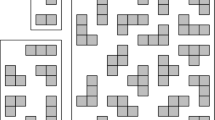Abstract
A d-dimensional polycube is a facet-connected set of cubes in d dimensions. Fixed polycubes are considered distinct if they differ in their shape or orientation. A proper d-dimensional polycube spans all the d dimensions, that is, the convex hull of the centers of its cubes is d-dimensional. In this paper we prove rigorously some (previously conjectured) closed formulae for fixed (proper and improper) polycubes, and show that the growth-rate limit of the number of polycubes in d dimensions is 2ed−o(d). We conjecture that it is asymptotically equal to (2d−3)e+O(1/d).
Similar content being viewed by others
References
G. Aleksandrowicz and G. Barequet: Counting d-dimensional polycubes and nonrectangular planar polyominoes, Int. J. of Computational Geometry and Applications19(3) (2009), 215–229.
G. Aleksandrowicz and G. Barequet: Counting polycubes without the dimensionality curse, Discrete Mathematics309(13) (2009), 4576–4583.
G. Barequet, M. Moffie, A. Ribó and G. Rote: Counting polyominoes on twisted cylinders, Integers (electronic journal) 6 (2006), #A22, 37 pp.
S. R. Broadbent and J. M. Hammersley: Percolation processes: I. Crystals and mazes; Proc. Cambridge Philosophical Society53 (1957), 629–641.
M. Eden: A two-dimensional growth process, in: Proc. 4th Berkeley Symp. on Mathematical Statistics and Probability, IV, Berkeley, CA, pp. 223–239, 1961.
D. S. Gaunt: The critical dimension for lattice animals, J. of Physics A: Mathematical and General13 (1980), L97–L101.
D. S. Gaunt and P. J. Peard: 1/d-expansions for the free energy of weakly embedded site animal models of branched polymers, J. of Physics A: Mathematical and General33 (2000), 7515–7539.
D. S. Gaunt, P. J. Peard, C. E. Soteros and S. G. Whittington: Relationships between growth constants for animals and trees, J. of Physics A: Mathematical and General27 (1994), 7343–7351.
D. S. Gaunt, M. F. Sykes and H. Ruskin: Percolation processes in d-dimensions, J. of Physics A: Mathematical and General9 (1976), 1899–1911.
T. Hara and G. Slade: The self-avoiding-walk and percolation critical points in high dimensions, Combinatorics, Probability, and Computing4 (1995), 197–215.
I. Jensen: Counting polyominoes: A parallel implementation for cluster computing; in: Proc. Int. Conf. on Computational Science, part III, Melbourne, Australia and St. Petersburg, Russia, Lecture Notes in Computer Science2659, Springer, pp. 203–212, June 2003.
D. A. Klarner: Cell growth problems, Canadian J. of Mathematics19 (1967), 851–863.
D. A. Klarner and R. L. Rivest: A procedure for improving the upper bound for the number of n-ominoes, Canadian J. of Mathematics25 (1973), 585–602.
W. F. Lunnon: Symmetry of cubical and general polyominoes, in: Graph Theory and Computing (R. C. Read, ed.), Academic Press, New York, pp. 101–108, 1972.
W. F. Lunnon: Counting multidimensional polyominoes, The Computer Journal18 (1975), 366–367.
N. Madras: A pattern theorem for lattice clusters, Annals of Combinatorics3 (1999), 357–384.
N. Madras, C. E. Soteros, S. G. Whittington, J. L. Martin, M. F. Skeys, S. Flesia and D. S. Gaunt: The free energy of a collapsing branched polymer, J. of Physics A: Mathematical and General23 (1990), 5327–5350.
J. L. Martin: The impact of large-scale computing on lattice statistics, J. of Statistical Physics58 (1990), 749–774.
J. W. Moon: Counting Labelled Trees, Canadian Mathematical Monographs, no. 1, Wiliam Clowes & Sons, London and Beccles, 1970.
P. J. Peard and D. S. Gaunt: 1/d-expansions for the free energy of lattice animal models of a self-interacting branched polymer, J. of Physics A: Mathematical and General28 (1995), 6109–6124.
D. H. Redelmeier: Counting polyominoes: Yet another attack; Discrete Mathematics36 (1981), 191–203.
M. Schwartz and T. Etzion: Two-dimensional cluster-correcting codes, IEEE Trans. on Information Theory51 (2005), 2121–2132.
N. J. A. Sloane: The on-line encyclopedia of integer sequences, available at http: //www.research.att.com/~njas/sequences.
S. Whittington and C. Soteros: Lattice animals: Rigorous results and wild guesses; in: Disorder in Physical Systems (G. Grimmett and D. Welsh, eds.), Clarendon Press, Oxford, pp. 323–335, 1990.
Author information
Authors and Affiliations
Corresponding author
Rights and permissions
About this article
Cite this article
Barequet, R., Barequet, G. & Rote, G. Formulae and growth rates of high-dimensional polycubes. Combinatorica 30, 257–275 (2010). https://doi.org/10.1007/s00493-010-2448-8
Received:
Published:
Issue Date:
DOI: https://doi.org/10.1007/s00493-010-2448-8




